An important component of the NSHS95 involved repetition of questions from the 1986 Nova Scotia Heart Health Survey. This was done to allow a comparison of population CVD risk levels in 1986 versus 1995 and to estimate changes in specific CVD risk factors over the last decade.
When comparing data on a population at two points in time, it is important to consider changes in the characteristics of the population that have occurred over time. The distribution of the population by age as well as the educational attainment might change and, therefore, may impact on the population's health. Characteristics of the Nova Scotia population in 1986 and 1995, based on the 1986 Nova Scotia Heart Health Survey (Nova Scotia Department of Health, Department of National Health and Welfare, 1987) and the NSHS95, are shown in Table 31. The distribution of the population between the three age groups was similar; although there was a slight increase in the percentage of people aged 35-64, and a slight decrease in the percentage of people aged 18-34. The distribution of the population by educational level changed quite dramatically. The population in 1995 was considerably more educated than the population in 1986. A higher percentage had completed secondary education (48% versus 39%) and a university degree (22% versus 13%).
Over the past decade, the average BMI increased significantly from 26 to 27 (p < 0.05), while the percentage of people in the healthy-to-low weight range remained the same. The percentage of people who were overweight (BMI of 27-29.9) or obese (BMI > 30) increased from 36% to 44%, with young women (18-34 years) and men over age 65 showing the greatest increase (p < 0.05) (Table 32).
[1] > 140/90 mmHg and/or on
treatment.
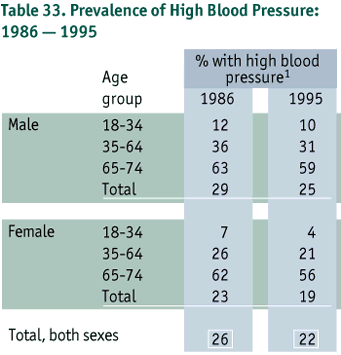
The prevalence of high blood pressure (>140/90 mmHg and/or on treatment) decreased in the last decade from 26% to 22% (p < 0.05), yet awareness and control of high blood pressure did not change. Approximately one-quarter of those with high blood pressure were aware of their condition, and were being treated and controlled. The remaining three- quarters were either aware of their condition but their blood pressure was uncontrolled or they were unaware that they had high blood pressure (Tables 33 and 34).
[1] The 'aware status' variable is computed differently
than in the original 1986 report, but the 1986 data have been rerun with
the new code.
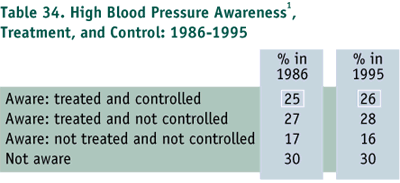
Questions about blood pressure measurement for 1986 and 1995 showed that there was an increase in the percentage of people who were told their blood pressure in numbers from 32% to 43% (p < 0.05) (Table 35).
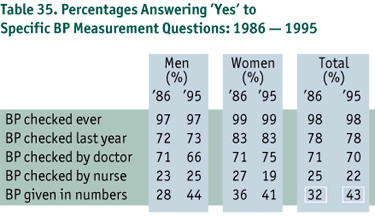
It is of concern that among those who had high blood pressure and were aware of their condition, only 50% were actively treating it with drugs, non- pharmacologic means (e.g. low sodium diet, weight control) or both (Table 36). There was virtually no change in the pattern of reported high blood pressure treatment between 1986 and 1995. The percentage of people reporting use of non- pharmacologic means was far from optimal, with 27% reporting it as a treatment used alone or in combination with drugs.
[1] Non-pharmacologic management e.g. low
sodium diet, weight control program, etc.
The population mean total blood cholesterol level decreased over the last decade from 5.31 to 5.24 mmol/L (p < 0.05), with the 35-64 age group showing the greatest change (p < 0.05) (Table 37).
[1] Plasma lipid level measured in 1986
survey were adjsted (3% increase)
to ensure comparability to serum
values measured in the 1995 survey.
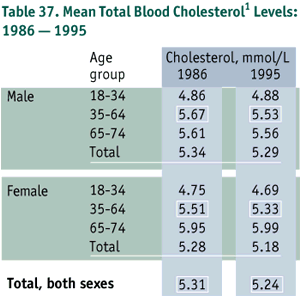
There were no statistically significant changes in the proportion of the population who were at moderate and high risk levels due to elevated blood cholesterol ( > 5.2 mmol/L and > 6.2 mmol/L respectively) (Table 38). In 1995, more respondents reported having had their blood cholesterol checked, (50% in 1995 vs. 20% in 1986, p < 0.05); and a greater number were told by a health professional that they had high blood cholesterol (5% in 1986, vs. 16% in 1995) (p < 0.05) (Table 39).
[1] Plasma lipid levels measured in the 1986 survey
were adjusted (3% increase)
to ensure comparability to serum values
measured in the 1995 survey.
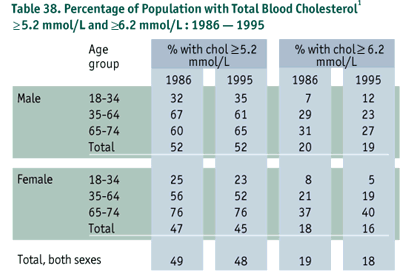
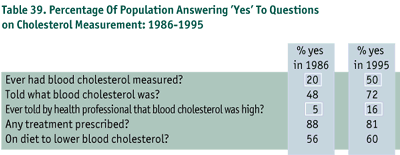
[1] smokes > 1 cigarette/day
every day.
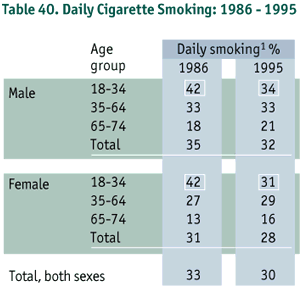
The proportion of adults who smoked daily did not change significantly over the past decade. However, the percentage of 18-34 year olds who smoked daily declined significantly in both men (from 42% to 34%) and women (from 42% to 31%) (p < 0.05) (Table 40).
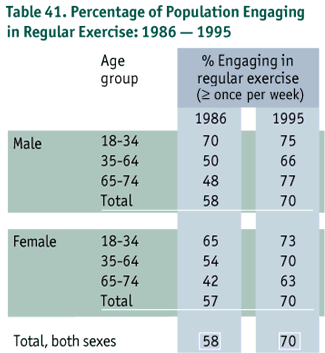
While 58% of the population reported exercising at least once per week in 1986, this number increased significantly to 70% in 1995 (p < 0.05). This finding reflects an increase in non-sedentary behaviour, one strategy advocated for improving health (Table 41).
[1] Major CVD risk factors are high blood
cholesterol, high blood pressure, and cigarette smoking.
[2] Plasma lipid levels measured in the 1986 survey were adjusted (3%
increase) to ensure comparability to serum values measured in the 1995
survey.
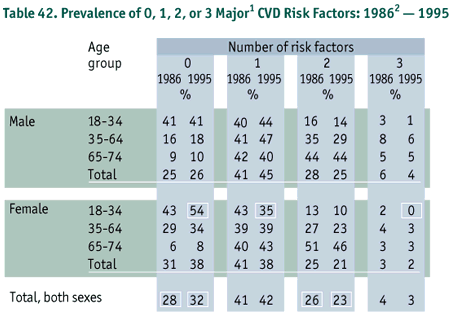
There was a statistically significant increase in the percentage of adults who had no major risk factors for CVD (high blood cholesterol, high blood pressure, or cigarette smoking) from 28% in 1986 to 32% in 1995, and it was females, particularly young females age 18-34, who contributed most to this change (p < 0.05). In fact, among young women (age 18-34) there were significant decreases in the percentage who had one and three major risk factors (p < 0.05). There was also a decrease in the percentage of adults who had two major risk factors (p < 0.05) (Table 42).
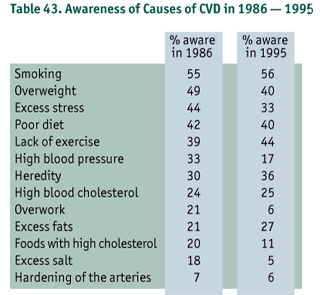
The percentage of the population reporting awareness of the various causes of heart disease changed over the decade, with statistically significant improvements for some factors and significant declines in others. Table 43 outlines these differences in awareness. Factors or behaviours where there was an increased level of awareness included lack of exercise, heredity, and excess fats (p < 0.05). Areas where level of awareness decreased included overweight, excess stress, high blood pressure, overwork, foods with high cholesterol, and excess salt (p < 0.05).
This concludes the retrospective comparison of CVD risk in 1995 versus 1986.
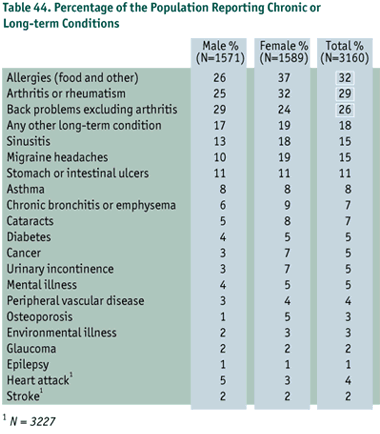
As people get older they tend to suffer from more chronic or long-term health problems. This often necessitates regular medical follow-up resulting in considerable personal, social and health-related costs. Much of the long-term care for chronic illness and disability involves ongoing pharmacological intervention and lifestyle change directed at helping clients adapt to living with continuing illness (Hasler&Schofield, 1990; Patrick&Peach, 1989; Roberts, et al, 1995). Respondents were asked to report any chronic (long-term) health problems currently affecting them and whether these conditions required regular medical or hospital follow-up (Table 44).
The most common chronic conditions were allergies, arthritis/rheumatism, and back problems, the latter two having an especially high cost in terms of personal suffering, lost productivity, and use of health resources (Badley, Rasooly,&Webster, 1994; Workers' Compensation Board of Nova Scotia, 1994 Annual Report).
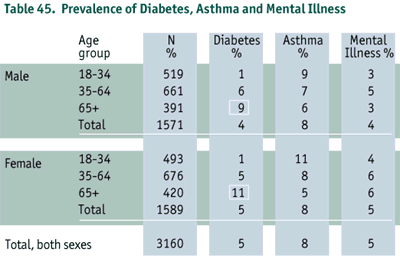
All conditions listed in Table 44 have personal and societal costs and require closer examination. However, due to limited space in this report, analysis has been limited to three conditions for which few provincial statistics exist. Table 45 presents additional information on diabetes, asthma, and mental illness. The prevalence of diabetes increased with age, while the prevalence of asthma and mental illness was relatively constant.
One-quarter of the population had at least one chronic condition, one-fifth had two conditions, and just over one-third had three or more. The percentage of people with three or more chronic conditions increased with age. In the oldest age group, significantly more women (66%) than men (47%) reported having three or more chronic conditions (p < 0.05) (Table 46).
[1] results do not take into account
differences in family size.
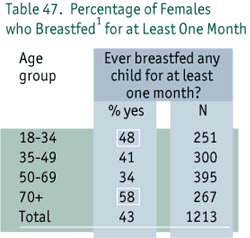
Breastfeeding benefits both infant and mother. Breast milk is easily digested, nutritionally sound as the sole source of nourishment for the first four to six months of an infant's life, and helps to reduce allergic tendencies in infants. Breastfeeding provides passive immunity to infants, controls milk intake optimally, helps develop oral musculature, and satisfies the infant's sucking reflex. For mothers, breastfeeding encourages mother/infant bonding, promotes weight loss following delivery, helps uterine tissue regain pre-pregnancy state, and provides a convenient, safe, environmentally sound, and inexpensive method of infant feeding (Nova Scotia Department of Health, 1995). Breastfeeding practices of Nova Scotian women have fluctuated over several generations. More women in the oldest age group (70 years of age and over) reported having breastfed their infants compared to women in the younger groups (p < 0.05). This rate declined for women aged 50-69 years and showed an increase for younger women, indicating a renewed interest in breast-feeding for mothers currently of child-bearing age (p < 0.05) (Table 47).
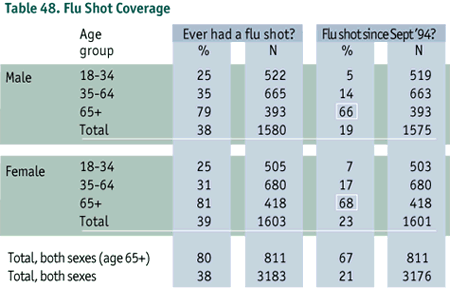
The practice of giving people in "high risk" groups a yearly vaccination against influenza is one of the most cost-effective ways of reducing deaths and complications from pneumonia. Groups who benefit from immunization include all those over age 65 as well as those under age 65 who have high risk conditions that require regular medical follow-up or hospital care, (e.g., chronic heart or lung disease). The Canadian Consensus Conference on Influenza (1993) recommends that by the 2000-2001 flu season, 70% of individuals in these groups should receive annual flu shots.
It is encouraging to note that approximately two-thirds of those aged 65 and over had a flu shot in the 1994-95 season (Table 48). However, only 25% of those in the younger "at risk" group (under age 65 with eligible chronic conditions) reported getting a flu shot in the 1994-95 flu season (Table 49).
[1] Chronic condition refers to the
presence of at least one of following conditions which required regular
medical follow-up or hospital care: asthma, bronchitis, sinustis,
diabetes, cancer, peripheral vascular disease, heart attack, or stroke.
Follow-up information was available for all these conditions was used, not
whether the person had follow-up for that condition.
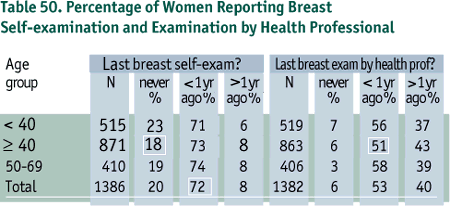
In Nova Scotia, breast cancer makes up 28% of all new cancers in women with 592 new cases diagnosed in 1994 (Nova Scotia Cancer Registry, 1993-1994). The chances of survival are much better when breast cancer is found and treated in its earliest stages. The Canadian Task Force on the Periodic Health Examination (1994) has recommended that women between the ages of 50 and 69 years have an annual breast examination done by a health professional. The Nova Scotia Breast Screening Program suggests that all women over 20 years of age perform a breast self- examination each month and that, in addition, all women over 40 have a manual breast examination done by a health professional at least once a year. It is encouraging that nearly three-quarters (72%) of adult women in Nova Scotia reported performing a breast self-examination in the past year and approximately one-half of the female population had received a breast examination by a health professional in the same time period. However, for those over 40, the fact that only 51% had a manual breast exam by a health professional in the past year and 18% had never performed a breast self-exam, is of concern (Table 50).
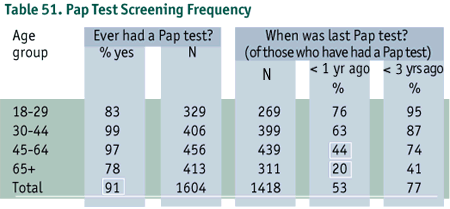
In Nova Scotia, cervical cancer makes up 3% of all new cancers in women, and 60 new cases were reported in 1994 (Nova Scotia Cancer Registry, 1993-1994). If cervical cancer is found and treated in its early stages, survival statistics are greatly improved. Papanicolaou smear (PAP) testing is an effective means to detect cervical cancer early; however experts do not agree on how often PAP tests should be done. The Canadian Task Force on the Periodic Health Examination (1994) suggests that PAP tests be included in the regular periodic check-up. The Nova Scotia Gynaecological Cancer Screening Program suggests that until an information system is in place to monitor screening frequency and issue screening reminder notices to women at recommended intervals, PAP tests should be done each year on all sexually active women 18 years of age and older (Miller, et al., 1991).
Although annual screening is recommended for all sexually active women over the age of 18 years, older women (those 45 and older) were less likely to have had a Pap test in the last year. Only 20% of women 65 and over, and 44% of those aged 45 to 64 reported having had a PAP test in the past year. The majority of women (91%) reported having had a PAP test at least once in their lifetime (Table 51).

Cancer of the prostate makes up 27% of new cancers in Nova Scotian men and 644 new cases were reported in 1994 (Nova Scotia Cancer Registry, 1993-1994). To screen for this type of cancer, doctors commonly do a digital rectal examination (DRE) checking for an enlarged prostate. The Canadian Task Force on Periodic Health Examination states, "There is poor evidence to include or exclude the digital rectal exam (DRE) from the periodic health examination for men over 50 years of age. While DRE has limitations in its ability to detect early prostate cancer, there is insufficient evidence to recommend that physicians who currently include DRE in their examinations should change that behaviour" (The Canadian Task Force on the Periodic Health Examination, p.812, 1994).
While 39% of all men reported having had a prostate examination, the figure rose to 68% in men aged 50 to 70 years. Among men aged 50-70 years, approximately one-third had never had an exam, 29% reported having had the examination less than one year ago, 13% said one to two years ago, and 26% said it was more than two years ago (Table 52).
This chapter described the health of adult Nova Scotians relative to standards and norms judged to be important by the scientific community and health care professionals. The information included both physiological measures and behaviours. The physiological measures included average BMI values, blood pressure, and blood cholesterol; and the behaviours included smoking, physical activity, and alcohol consumption. In addition, comparisons were presented on cardiovascular disease risk factors between the current data and 1986 data from the first Nova Scotia Heart Health Survey (Nova Scotia Department of Health, Department of National Health and Welfare, 1987). Other topics that concern health providers and consumers included the prevalence of specific chronic conditions such as allergies, asthma, or back problems; a historical profile of the practice of breastfeeding among women of all ages in the population; and participation in prevention programs including flu shots, breast screening, PAP tests, and prostate exams.
While approximately one-third of Nova Scotians had a BMI in the healthy weight range, a large proportion of the population was overweight, particularly men (48% with BMI > 27). Of the men who were overweight, three- quarters acknowledged the fact, yet only one-third were trying to lose weight. While a smaller proportion of women were overweight (39%) most acknowledged the fact, and half were trying to lose weight. It is of concern that some women in the young and middle age groups who were in the healthy to low weight range believed that they were overweight and were trying to lose weight. Culturally, women are more conscious of their weight and feel more pressure to be thin. The data were consistent with these cultural norms. Exercising and eating lower-fat foods were the most common strategies for reducing weight.
Total blood cholesterol, LDL, and triglyceride levels showed similar patterns in the population and generally increased with age. HDL levels were consistent across age groups and were more favourable for women. The estimated proportion of the population at risk with high blood lipids differed with each measure. Nearly half of adults were at risk when referring to total blood cholesterol, and 18% were at high risk. When referring to the LDL levels, about 38% were at risk, and 16% were at high risk; and when referring to triglyceride levels 22% were at risk. Women over 65 contributed most heavily to all of these risk categories. About one half of Nova Scotians reported having had their blood cholesterol measured at some time prior to the survey.
The prevalence of high blood pressure increased with age from about 10% in the lower age group to about 60% in those 65 years and older. Most Nova Scotians had their blood pressure checked in the past year, however there is an opportunity to help those with high blood pressure manage it more effectively. Only 25% of those who had high blood pressure were controlling it through treatment, and 31% were unaware that they had high blood pressure.
One of the most important behaviours that affects health is smoking, and 29% of Nova Scotia's adult population currently smoke cigarettes daily (about one-third of these were heavy smokers who smoked 25 or more cigarettes daily). About one-quarter of the adult population was exposed to second-hand smoke or environmental tobacco smoke (ETS) every day outside the home, and nearly one- quarter of those exposed indicated that it led to health problems such as breathing difficulties and eye irritation. Given the health risks associated with breathing ETS, it is surprising that a relatively small portion of the population found it to be a problem.
While 61% of Nova Scotians reported participating in leisure time physical activity in the week prior to the survey, the percentage declined with age, and 39% reported no such activity. While this is only one measure of physical activity, it suggests a substantial proportion of the Nova Scotia population has a sedentary lifestyle. Methods to improve leisure time physical activity in the population deserve further examination given the emphasis placed on associated health benefits by national programs such as Active Living and Participaction.
Men consumed more alcohol than women over the past year. Older men tended to drink more frequently, but the number of drinks per occasion decreased. The fact that moderate drinkers form a larger group than heavy drinkers and thus contribute to a greater proportion of health problems, means that effective strategies to prevent alcohol-related problems must focus on drinkers generally and not just on the minority who use alcohol in large quantities (Rankin&Ashley, 1992).
Given the number of health problems associated with excessive weight, elevated blood lipids, high blood pressure, smoking, sedentary lifestyle, and overconsumption of alcohol, more effort is required in the areas of education, policy, and research to alleviate the social and personal costs associated with the current health status of Nova Scotians.
When the NSHS95 looked at the three major risk factors for cardiovascular disease (high blood cholesterol, high blood pressure, and smoking), more than two- thirds of the Nova Scotia adult population was found to be at risk with one or more these factors, and the prevalence of risk increased with age. These and other risk factors were compared to 1986 data to show changes over the past decade.
Several changes in Nova Scotia's CVD risks were noted between 1986 and 1995:
Chronic illness that required medical follow-up affected one-quarter of the adult population. People over age 65 had more chronic conditions than any other age group. Multiple chronic conditions (three or more) were more evident in the older age group. This increased prevalence may be due to the fact that women live longer and therefore are more likely to experience an increased rate of chronic illness. Allergies, arthritis or rheumatism, and back problems were the predominant chronic illnesses reported by Nova Scotians.
Breastfeeding helps to reduce the level of chronic allergies in children. This and other benefits have led public health officials to promote breastfeeding. The data showed that the prevalence of breastfeeding is increasing from previous generations but has yet to reach the levels reported by women who are now over 70 years of age.
Flu vaccination, breast examinations, PAP tests, and prostate screening are important disease prevention activities supported by Nova Scotia's health system. In the 1994-95 season 67% of adults over 65 years of age received a flu shot, while only 25% of those under age 65 and considered at risk were vaccinated. The figure for those over age 65 satisfies national recommendations, while the figure for those under age 65 falls considerably short.
The Nova Scotia Breast Screening Program recommends yearly manual breast examinations by a professional for women aged 40 years and older. Only 51% of women in this age group reported having had an exam. Also, the program recommends that women over 20 perform a self-examination every month, and over 70% reported performing self-exams within the past year. These figures suggest that extra effort is needed to improve this preventive practice. Currently, the Nova Scotia Gynaecological Cancer Screening Program suggests that sexually active women should have a PAP test annually. Most women in the younger age groups reported having had a PAP test, however testing for women in the peri- and post-menopausal age groups (45 and older) was lower than expected.
The Canadian Task Force on the Periodic Health Examination (1994) recommends that doctors continue performing the digital rectal exam as part of regular check-ups of men aged 50 to 70. Sixty-eight percent of men in this age group reported having had a prostate exam, and 29% had the exam in the past year.
The physiological and behavioural indicators reviewed in this section were examined in relation to standards and norms judged to be essential for maintaining good health. There is room for improvement in certain preventive health practices, including the number of women who breastfeed, those age 65 and under considered at risk and in need of a flu shot, women over 40 receiving a breast exam, and peri- and post-menopausal women receiving a pap smear.
The proportion of the population with high blood pressure, high total blood cholesterol, and high weight; combined with the prevalence of smoking, alcohol consumption, sedentary lifestyles, and multiple risk factors presents a serious challenge to Nova Scotia's health system with its goal to improve and maintain the health of the population. Over the past 10 years there were small, yet statistically significant reductions in the prevalence of certain cardiovascular disease risks in the population. These included sedentary lifestyle, high blood pressure, and mean total blood cholesterol levels.
Minimizing the health risks by advocating and practising health promotion and illness prevention strategies as well as creating environments that support health should continue to play an important role in achieving optimum health.